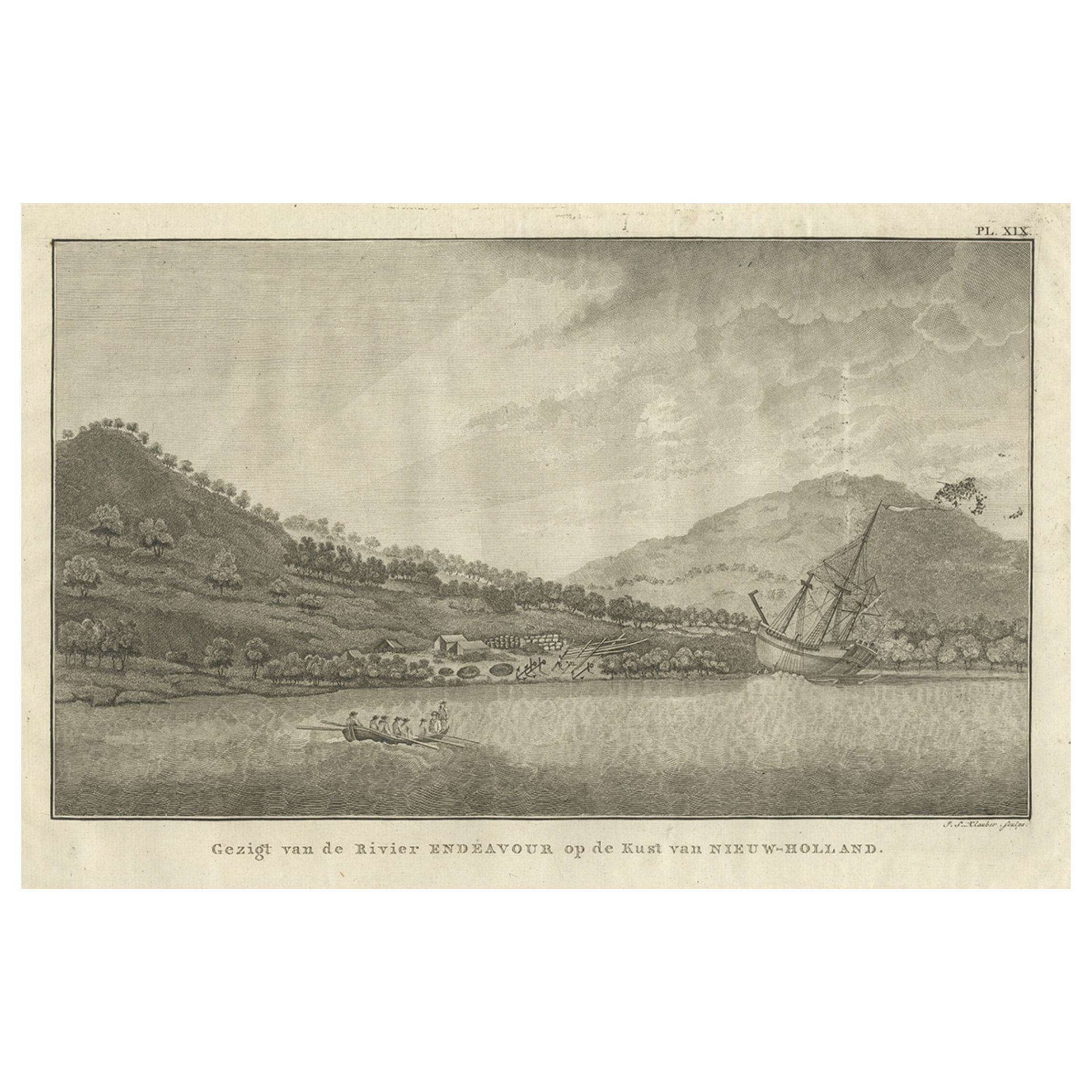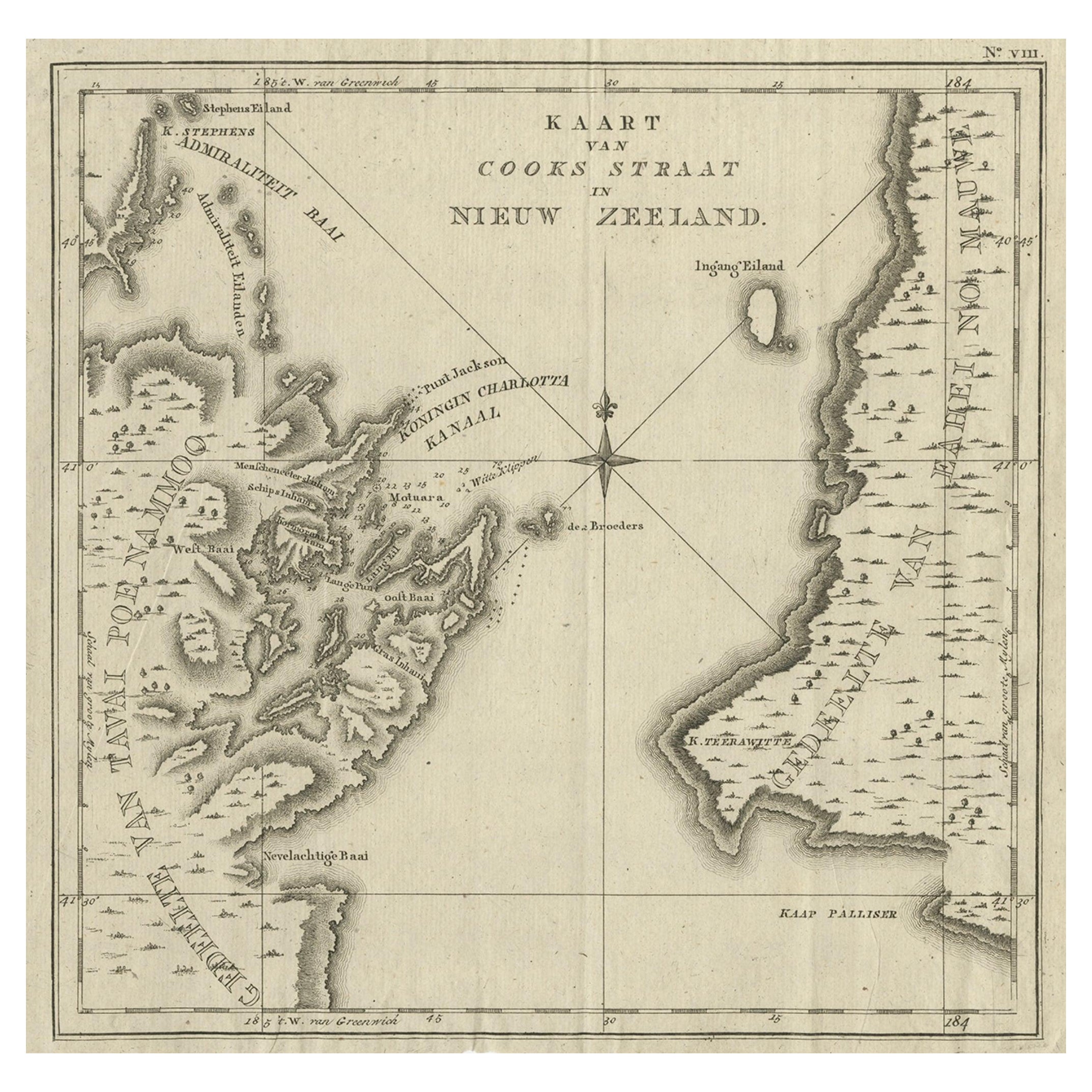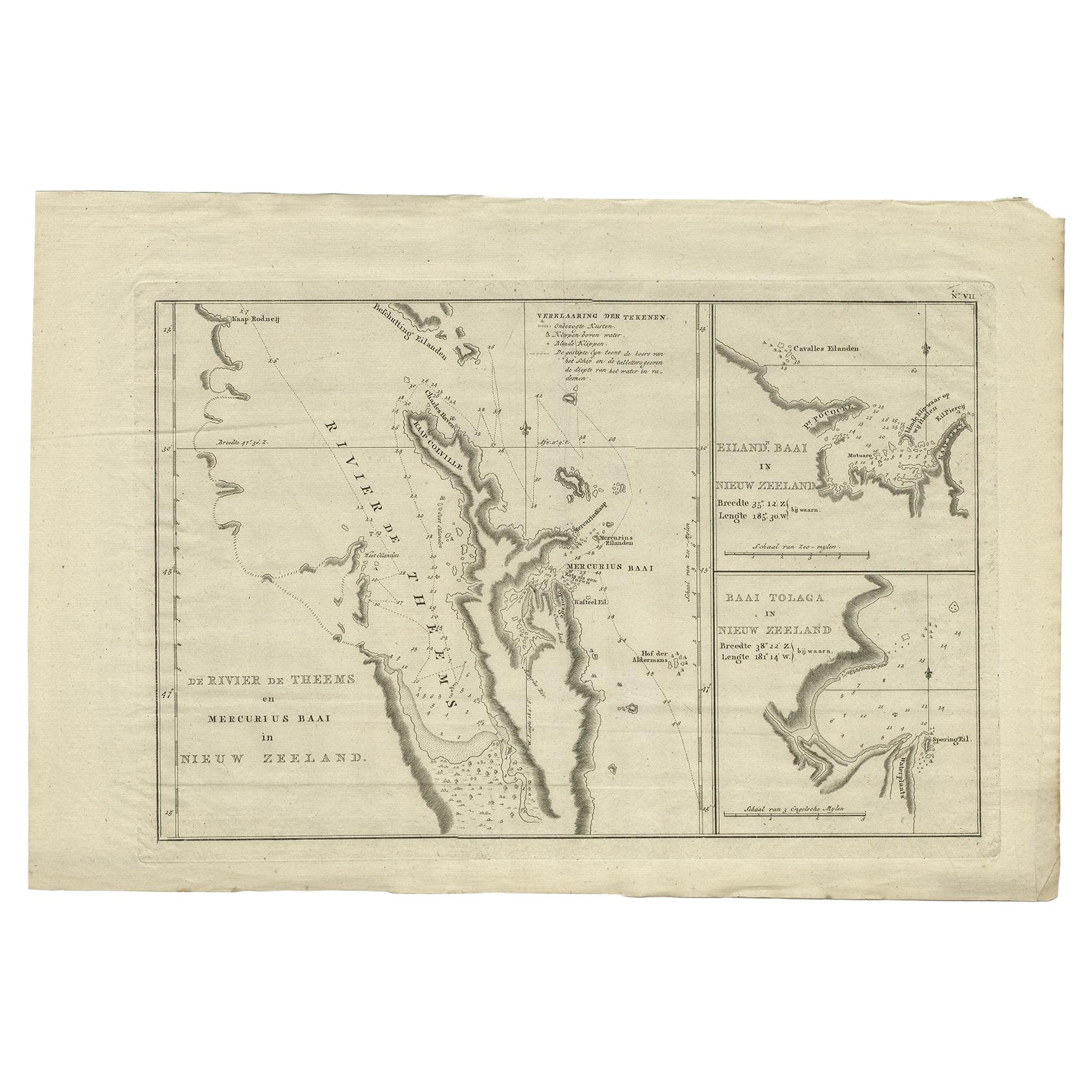Items Similar to Presentation silver to the Master Shipwright of Captain Cook’s Endeavour
Want more images or videos?
Request additional images or videos from the seller
1 of 10
Presentation silver to the Master Shipwright of Captain Cook’s Endeavour
About the Item
A George III shaped circular silver salver, plain within a shell and scrolling wave border and outer gadrooned edge, engraved with the royal coat of arms, crest and motto (period 1714-1800) of King George III and, on the reverse with a presentation inscription: For the Launching of His Majestys sloop ‘Otter’ 14 Gunns 305 Tonns 26 October 1767 & His Majestys ship ‘Egmont’ 74 Gunns 1643 Tonns 29 August 1768 by Mr Adam Hayes Master Shipwright of his Majestys yard at Deptford; further monogrammed A*H P A*M. Hallmarked for Benjamin Cartwright, London, 1769
Adam Hayes (1710-1785) began his career as ship’s carpenter in Centurion during Commodore Anson’s famous voyage around the world in 1740-44 when he saw action and shared in the capture of the Spanish treasure galleon Nuestra Señora de Covadonga. In 1746, under Anson’s patronage, Hayes was appointed master shipwright at Gibraltar before working under the eminent naval architect Thomas Slade – designer of HMS Victory – at Plymouth, Sheerness, Woolwich and Chatham. Appointed master shipwright to Deptford in 1755, Hayes specialised in building 74-gun third-rate warships such as Magnificent, Albion, Superb, Dragon and in 1768, as detailed on this small salver, HMS Egmont which saw action at the 1797 Battle of Cape St Vincent. Launched a year earlier at a cost of £6,500, Otter was a Slade designed 14-gun sloop of war which, during service in North America, was wrecked off Florida in 1778.
Hayes, however, is best known for selecting and re-fitting the merchant collier Earl of Pembroke as a Royal Navy bark for a scientific mission to the Pacific Ocean under the command of Captain James Cook. No doubt Hayes’s seafaring experience with Anson selected him for this high-profile task. At a cost of £2,200, he sheathed and caulked Pembroke’s leaky hull, installing an additional internal deck to provide living quarters for Cook and the scientific members of the Royal Society assigned to the voyage. Hayes’s original plan for the converted ship is at the National Maritime Museum, Greenwich (ZAZ6587). Commissioned into the Royal Navy as Endeavour, the ship left Deptford on 30 July 1768, just a few weeks before the launch of Egmont. On 29 April 1770, Endeavour became the first European vessel to make landfall on the east coast of Australia.
- Dimensions:Height: 1.5 in (3.81 cm)Diameter: 10.25 in (26.04 cm)
- Style:George III (Of the Period)
- Materials and Techniques:
- Place of Origin:
- Period:1760-1769
- Date of Manufacture:1769
- Condition:Wear consistent with age and use.
- Seller Location:Lymington, GB
- Reference Number:1stDibs: LU973035087502
About the Seller
5.0
Recognized Seller
These prestigious sellers are industry leaders and represent the highest echelon for item quality and design.
Established in 1982
1stDibs seller since 2013
106 sales on 1stDibs
Typical response time: 4 hours
Associations
LAPADA - The Association of Arts & Antiques Dealers
- ShippingRetrieving quote...Ships From: Lymington, United Kingdom
- Return PolicyA return for this item may be initiated within 14 days of delivery.
More From This SellerView All
- Captain Sir George Collier’s Presentation Silver Entree Dishes by Richard CookeBy Richard CookeLocated in Lymington, HampshireCaptain Sir George Collier’s presentation silver entree dishes and covers by Richard Cooke, London 1803, each plain rectangular with gadroon borders, covers with detachable vine twist handles, the covers engraved: ‘Presented by the Old Madras Insurance Company to Captn. Collier, Commander of His Majestys Sloop ‘Victor’, for his persevering & gallant conduct in chasing for two days, partially engaging & ultimately sinking the French National Corvette ‘La Fleche’ of superior force while advantageously anchored at the Mahé Islands.’ Dimensions approx.: 150 x 290 x 200mm / 6 x 11 ½ x 8 inches Total weight approx.: 3513 grams / 112 oz. troy. Footnotes: These silver dishes were presented to Captain Sir George Collier KCB (1774-1824) for destroying the 22-gun French corvette La Flèche whilst commanding Victor, 18 guns, in the Seychelles on 5 September 1801. After escorting troop transports into the Red Sea ahead of the British invasion of Egypt, Victor fell in with La Flèche off Diego Garcia. After an initial engagement, the corvette escaped to windward only to be found again four days later. A short but fierce action ensued during which the corvette caught fire, grounded on a coral reef and sank before a prize crew could secure the ship. As reward, the Admiralty made Collier post captain and gave him command of Leopard, 50 guns. Born in London, Collier entered the Royal Navy in 1784. As a midshipman, he was wrecked off Madagascar in 1792 surviving among the natives of that island for six months before being rescued by a passing Portuguese brig. Unfortunately, the brig was immediately captured by a French privateer and for two more years, Collier was confined as a prisoner of war on Mauritius. Returning to service in 1795, he was given his first command in Suffolk Tender. Following the Peace of Amiens, Collier commanded the Sea Fencibles at Liverpool. After accompanying the expedition to Copenhagen in 1808, for which he was knighted for delivering the admiral’s dispatches, he saw action, and was wounded, supporting the military Campaign in Spain. After the war, Collier was made commodore on the African station where he was employed suppressing the slave trade with such rigour that he was elected an honorary member of the African Institution, founded by William Wilberforce...Category
Antique 19th Century British Historical Memorabilia
MaterialsSilver
- Fine Presentation Sword Given to Lieutenant Charles PeakeLocated in Lymington, HampshireA fine presentation sword given to Lieutenant Charles Peake as a token of gratitude by the Men of His Ship when recommissioned for Foreign Service i...Category
Antique 1820s English Arms, Armor and Weapons
MaterialsMetal
- Silver salver of a Hero of Trafalgar: Captain Pryce Cumby London, circa 1836Located in Lymington, HampshireA William IV silver salver with shellwork and scroll border, on four feet, profusely chased and engraved with foliate decoration and inscribed in the centre beneath a widow’s coat of...Category
Antique 1830s English Sterling Silver
MaterialsSilver
- Presentation Model of America’s Cup Winner America by G. L. WatsonLocated in Lymington, HampshireThis cased presentation half hull model is of the first winner of the America’s Cup, the schooner America. The copper coloured bottom is painted with black topsides and has a finely carved garland around the bow. There are two stump masts, a caprail and bowsprit. It is set on a mahogany backboard with a Bakelite name plaque engraved ‘Schooner Yacht ‘America’ Scale ¼ = 1 foot to W.G.J. from G.L.W’. A label identifies the case maker as ‘Lambert Picture Frame Manufacturer, 34 Albert Gate, Hyde Park, S.W.’ and another describes the model, including the fact that the case was added in 1903. It then explains the initials W.G.J. and G.L.W. ‘This model was presented by G.L.Watson to W.G.Jameson. George L.Watson was one of England’s leading yacht designers. He designed four America’s Cup Challengers which included: Thistle, Valkyrie, Valkyrie II and Shamrock II. He also designed the King’s Britannia, and the Kaiser’s Meteor. William G.Jameson was probably the most successful amateur helmsman in the U K in the 1880’s and the 1890’s. Jameson introduced Lord Dunraven to yacht racing in 1887. Dunraven was to build three challengers for the America’s Cup, all designed by G.L.Watson. Jameson in 1892 acted as an adviser to the Prince of Wales and introduced him to Watson who designed his Britannia. Jameson also advised Thomas Lipton in his Shamrock II challenge. Clearly, Watson and Jameson worked closely throughout their careers. Scottish, 1887. Provenance: 1887 George L. Watson presented this half hull to William G. Jamieson 1903 Unknown owner(s) thence The Glen Foster Collection 1999 Hyland Granby Antiques, Hyannis Port, Massachusetts 2002 The Kelton Collection of Maritime Art & Artifacts Probably the most famous racing yacht ever built, and the first winner of the America’s Cup, this schooner, designed by James and George Steers, was built by a syndicate of New York Yacht Club members to sail to England. The purpose of this visit was twofold: to show off U.S. shipbuilding skills and make money through competing in regattas. Only launched on 3rd May 1851, she had crossed the Atlantic and won the 53-mile race around the Isle of Wight by 22nd August that same year. America was captained by Richard Brown, who was a skilled member of the Sandy Hook Pilots group, renowned worldwide for their expertise and speed in manoeuvering schooner-rigged pilot boats...Category
Antique 1880s Scottish Nautical Objects
MaterialsMahogany
- Miniature Brass Cannon in a Presentation CaseLocated in Lymington, HampshireA miniature brass cannon in a presentation case, the 5-stage cannon and carriage in a rectangular, glazed presentation case, raised upon tiers of reeded, ...Category
Vintage 1910s British Historical Memorabilia
MaterialsBrass
- A silver goblet presented to Captain W. G. Hackstaff, 1830Located in Lymington, HampshireThis flared silver cup has a border of repoussé scrolls and foliage on the lower bulb of the goblet and around the foot. The full inscription is written below. Partially assayed fo...Category
Antique 1830s English Sterling Silver
MaterialsSilver
You May Also Like
- Captain Cook's Encampment in Australia where The Endeavour was Beached, 1803Located in Langweer, NLAntique print Australia titled 'Gezigt van de Rivier Endeavour op de Kust van Nieuw-Holland'. View of an encampent on the shore of the Endeavour river on the coast of Australia where the Endeavour boat was beached. Originates from 'Reizen Rondom de Waereld door James Cook (..)'. HMS Endeavour was a British Royal Navy research vessel that Lieutenant James Cook commanded to Australia and New Zealand on his first voyage of discovery from 1768 to 1771. She was launched in 1764 as the collier Earl of Pembroke, with the Navy purchasing her in 1768 for a scientific mission to the Pacific Ocean and to explore the seas for the surmised Terra Australis Incognita or "unknown southern land". Commissioned as His Majesty's Bark Endeavour, she departed Plymouth in August 1768, rounded Cape Horn and reached Tahiti in time to observe the 1769 transit of Venus across the Sun. She then set sail into the largely uncharted ocean to the south, stopping at the islands of Huahine, Bora Bora, and Raiatea west of Tahiti to allow Cook to claim them for Great Britain. In September 1769, she anchored off New Zealand, becoming the first European vessel to reach the islands since Abel Tasman's Heemskerck 127 years earlier. In April 1770, Endeavour became the first European ship to reach the east coast of Australia, with Cook going ashore at what is now known as Botany Bay. Endeavour then sailed north along the Australian coast. She narrowly avoided disaster after running aground on the Great Barrier Reef, and Cook had to throw her guns overboard to lighten her. Endeavour was beached on the Australian mainland for seven weeks to permit rudimentary repairs to her hull. Resuming her voyage, she limped into port in Batavia in October 1770, her crew sworn to secrecy about the lands that they had visited. From Batavia Endeavour continued westward, rounded the Cape of Good Hope on 13 March 1771 and reached the English port of Dover on 12 July, having been at sea for nearly three years. The ship was largely forgotten after her Pacific voyage, spending the next three years hauling troops and cargo to and from the Falkland Islands. She was renamed in 1775 after being sold into private hands, and used to transport timber from the Baltic. Rehired as a British troop transport during the American War of Independence, she was finally scuttled in a blockade of Narragansett Bay, Rhode Island in 1778. Historical evidence indicates the ship was sunk just north of Goat Island in Newport Harbor, along with four other British transports. Relics from Endeavour are displayed at maritime museums worldwide, including an anchor and six of her cannon. A replica of Endeavour was launched in 1994 and is berthed alongside the Australian National Maritime Museum in Sydney Harbour. The NASA Space Shuttle...Category
Antique Early 1800s Prints
MaterialsPaper
- Captain Cook's Exploration of Tahiti 18th C. Hand-Colored Map by BellinBy Jacques-Nicolas BellinLocated in Alamo, CAThis beautiful 18th century hand-colored copper plate engraved map is entitled "Carte de l'Isle de Taiti, par le Lieutenant J. Cook" was created by Jacques Nicolas Bellin and publish...Category
Antique Mid-18th Century French Maps
MaterialsPaper
- Antique Map of Cook's Strait in New Zealand, 1803Located in Langweer, NLAntique map New Zealand titled 'Kaart van Cooks Straat in Nieuw Zeeland'. Antique map of Cook's Strait in New Zealand. Originates from 'Reizen ...Category
Antique 19th Century Maps
MaterialsPaper
- Very Attractive Antique Map of the World as Planisphere, Shows Cook's VoyagesLocated in Langweer, NLAntique map titled 'Chart of the World, according to Mercators Projection'. This world map shows the various discoveries of Captain James Cook during his 3 voyages between 1768 and 1780, and the English and French Explorers who followed immediately thereafter, including Vancouver and La Perouse. This edition of the map is significantly revised from the editions issued immediately after the official report of Cook's Voyages were integrated into the map, showing better detail in New Zealand, Australia, the Northwest Coast of America and North East coast of Asia, along with Greenland. A new large lake also appears for the first time in the Western part of North America, shortly before the commencement of the Lewis...Category
Antique Late 18th Century Maps
MaterialsPaper
- Old Map of Cook's Discovery and Charting of the East Coast of Australia, 1803Located in Langweer, NLAntique map titled 'Kaart van Nieuw Zuid Wales of de Oostlyke Kust van Nieuw Holland ontdekt en onderzogt door den Luitenant J. Cook met het Schip de Endeavour in het Jaar 1770'. ...Category
Antique Early 1800s Maps
MaterialsPaper
- Detailed Map of New Zealand Showing the Route of Capt. Cook's First Voyage, 1803Located in Langweer, NLAntique map New Zealand titled 'De Rivier de Theems en Mercurius Baai in Nieuw Zeeland'. Detailed map of New Zealand showing the route of Capta...Category
Antique 19th Century Maps
MaterialsPaper
Recently Viewed
View AllMore Ways To Browse
Antique Nautical Portholes
Large Nautical Ships Wheel
Antique Marine Binoculars
Deep Sea Divers Helmet
Dixie Ii
Harpoon Gun
Vintage Spyglass
Antique Divers Helmet
Antique Miners Hat
Antique Nautical Pocket Compass
Life Ring Buoy
Nautical Walking Stick
Whale Tooth Scrimshaw
Compass Handheld
Portuguese Barometer
Sovereign Of The Seas Model
Antique Boxed Yacht Compass
Antique Fish Aquarium





